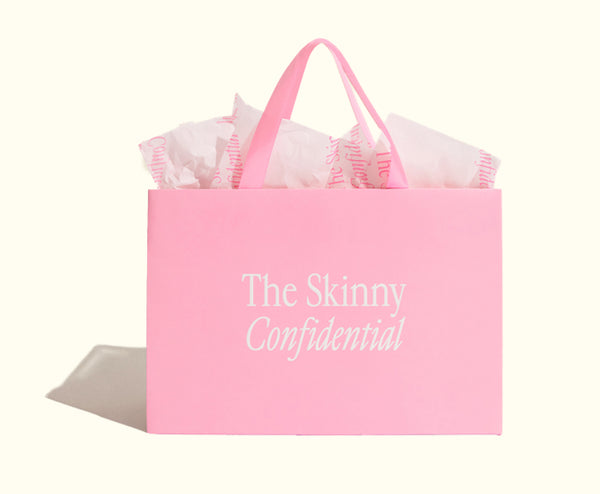
When it comes to wellness, we tend to focus on two things: how we feel and how we look. Most of our routines start with caring for our hair, skin, and nails because they’re the most visible reflections of our inner health.
And when redness sneaks its way onto our complexion? It can feel discouraging—especially if you’re already super intentional about your skincare routine.
Your texture may feel silky and flawless, but dark spots and discoloration totally steal the spotlight. There are plenty of reasons you might be dealing with redness, but fortunately, there are also plenty of ways to fix it.
Today, we’re sharing our top tips for getting an even, glowing complexion so you can finally retire your color-correcting palette.

How to Reduce Redness on Face Like a Pro
Redness on the skin happens when there’s increased blood flow near the surface due to inflammation. Sometimes it’s due to symptoms of rosacea, sometimes it’s due to a condition called “Spider Veins,” and other times, it’s just due to lifestyle changes.
Essentially, when your body detects an injury or threat, it sends immune cells to that area to start the healing process. To help them get there, your blood vessels widen and become more permeable, allowing more blood and nutrients in.
This immune activity is meant to help you heal, then fade once the job’s done. But when inflammation becomes chronic, the skin can stay flushed, red, and even swollen.
Here’s the question, though: What exactly is causing that inflammation in the first place? Let’s dive into what might be triggering your skin and contributing to that persistent redness.
(And, if you need a different kind of support, here’s how to reduce swelling in the face fast.)
What Causes Redness on Face?
-
Skin Sensitivity
-
Rosacea
-
Eczema
-
Lupus
-
Seborrheic Dermatitis
-
Sun Exposure
-
Weather Changes
-
Allergic Reactions
-
Acne and Inflammation
-
Over-Exfoliation
-
Overuse of Products
-
Harsh Treatments
-
Heat Exposure
-
Stress
-
Alcohol
-
Caffeine
-
Spicy Foods

How to Get Rid of Redness on Face
Identify the cause.
Before treating skin for redness, you have to know what’s causing it. Managing types of rosacea or other chronic skin conditions is totally different than reversing sun damage or identifying a food sensitivity.
So, before you jump into a new skincare routine, figure out where your redness, bumps, swelling, and other symptoms are coming from.
You can usually rule out a lot of triggers just by looking at your lifestyle and habits. That said, if you’re struggling to figure it out, you can always talk to your doctor or dermatologist. They can help point you in the right direction!
Simplify your skincare routine.
A lot of the time, your skincare is what’s causing the redness on your face. Kind of contradictory, we know. However, too many active ingredients, targeted treatments, or exfoliating practices can leave your skin RAW.
Even though all these products are beneficial, when mixed, they can make a chemical concoction that’s not skin-friendly at all. This is especially true if you have naturally sensitive skin.
So, edit it all down. Go back to basics. Pause the exfoliants and active treatments, then slowly reintroduce products one at a time to figure out what’s triggering the irritation.
And if you need a little help in the right direction, check out: “Do You Exfoliate or Cleanse First?” It’s a simple switch that can totally transform your skincare routine.
Be mindful of the ingredients in your products.
When you’re choosing products, make sure you’re actually reading the labels. Some actives are great for oily or combination skin types, but too harsh for more reactive skin.
Also, you can’t just include “cleansing” ingredients in your skincare routine. You need additives that will hydrate, soothe, and repair, too.
Retinoids, vitamin C, AHAS, BHAs, fragrances, essential oils, and benzoyl peroxide are all strong actives that may be causing problems. Cut back on these ingredients to see if your skin tone improves.
Additionally, try adding in calming skincare ingredients like aloe vera, hyaluronic acid, ceramides, squalane, niacinamide, and allantoin. These are great for improving tone and texture.
Give your moisture barrier attention.
Your moisture barrier is the outermost layer of your skin—it locks in hydration and protects you from environmental stressors.
Think of it as a shield for the more vulnerable layers underneath. When your barrier is compromised, products, pollution, and other irritants can penetrate deeper, triggering redness and irritation.
The fix? Take care of your moisture barrier. Barrier creams and SPF go a long way in strengthening your natural skin shield and helping restore a healthy, even complexion.
Hydrate in layers.
Hydration is your best friend when it comes to soothing inflammation and reducing redness. But a quick layer of moisturizer isn’t enough.
To balance oil, strengthen your skin barrier, and fully hydrate, it’s important to layer hydrating products. Start with a hydrating cleanser, follow with a hydrating toner, then a hydrating serum, and finish with a rich moisturizer and SPF.
These layers give your skin the support it needs to recover and maintain a healthy, even color.
Use a targeted spot treatment.
If your redness comes from acne, this step is for you—otherwise, skip it! Using spot treatments on non-acne-related redness can actually make irritation worse.
For breakouts, targeted treatments like salicylic acid, adapalene, or benzoyl peroxide are super effective. Instead of applying them all over your face, though, make sure to only dab them on the affected areas.
This approach helps clear acne and the redness that comes with it, without unnecessarily irritating the rest of your skin.
Bottom line: Treat acne where it exists. Don’t cover your entire face if you deal with reactive skin or chronic redness.
Protect your skin from the sun.
UV damage is one of the number one causes of skin redness! The sun can destroy your moisture barrier and, of course, burn your skin.
When this happens, your body triggers inflammation to heal the injury. So, if you’re not wearing SPF every day (or you’re not reapplying throughout the day)? That redness could be from sun damage.
Also, before you ask: Yes, you need sunscreen in the shade. And in the winter. And inside. ALWAYS.
So, always finish your morning skincare routine with a hydrating sunscreen and prioritize sun protection all day, every day.
Avoid potential triggers.
There are a lot of things that could irritate your skin that we’ve already addressed: harsh products, acne, medical conditions, and sun damage.
However, there are plenty of other triggers for redness. Evaluate your lifestyle and see what external factors could be causing your inflammation.
Spicy foods, alcohol, and caffeine are common culprits that can lead to flushing and redness. Eating something you’re allergic to can also trigger an immune response and cause redness.
Beyond what you eat, stress, extreme heat, and pollution can all inflame the skin. If you’re unsure what’s causing it, try removing one potential trigger at a time and watch how your skin responds.
Use cold therapy and massage.
So, the problem with inflammation is that it widens those blood vessels. This means more blood flow and red, swollen skin.
To combat that, constrict blood vessels using cold therapy! It can reduce redness and soothe any irritation that comes from inflammation.
But don’t worry, you don’t need to jump into an ice bath to see results. Instead, massage daily with a high-quality cold therapy tool like The Skinny Confidential Mint Roller.
It’s a dual-sided aluminum roller that's intuitively designed to address inflammation, sculpt the face, and help you feel amazing.
It’s self-care and skincare—the best combo.

What to Use for Redness on Face
Gentle, Non-Foaming Cleansers
For your double cleanse, stick with gentle, non-foaming cleansers to avoid irritation. Start with an oil-based cleanser, like Agent Nateur Holi Cleansing Face Oil. This melts away makeup, sunscreen, and buildup.
Then follow with a water-based cleanser, such as RX Hydra Exosome Cleanser. It’ll remove any remaining residue left behind to ensure your skin is truly clean and ready to absorb other products.
Both products are formulated for sensitive skin. So, they’ll thoroughly cleanse without stripping moisture or worsening redness.
Balancing Toners
Toners are like hydrating treatments that help balance your skin’s pH and create that first layer of moisture.
Choose an alcohol-free formula with plenty of soothing, anti-inflammatory ingredients like centella, green tea, or allantoin. We love RX Bio Exosome Ampoule Power Pep!
Hydrating Serums
Serums are the perfect next layer of hydration because they deliver active ingredients that get moisture deeper into the skin.
However, face oils aren’t just amazing at creating a hydrating base. They also strengthen the moisture barrier, boost the effectiveness of your moisturizer, and calm inflammation from the inside out.
The TSC Face Oil is super hydrating and packed with antioxidants that protect the skin and soothe inflammation.
Apply it with a TSC Mint Roller for added cold therapy bonuses!
Rich Moisturizers
Now it’s time for the true moisturizer. Choose something that’s rich and includes plenty of humectants like hyaluronic acid, glycerin, panthenol, and aloe vera. These are ingredients that draw moisture deep into the skin.
Also, look for bonus actives that are anti-inflammatory, soothing, and repairing. Try Epicuren Colostrum cream or Dr. Dennis Gross Skincare Vitamin C Lactic Dewy Deep Cream as your rich moisturizer.
Barrier Repair Creams
At this point in your skincare routine, you’ve done a lot of work to hydrate. To hold it all in, you want to finish your moisturizing process with a barrier repair cream.
We recommend a high-quality product, like the First Aid Beauty Ultra Repair Cream Intense Hydration that’s loaded with barrier-repair ingredients. Ceramides, colloidal oatmeal, shea butter, squalane, and more help make this barrier cream super effective.
Mineral Sunscreens
To protect that skin barrier, you need a great quality sunscreen. We like multi-tasking SPF like the TSC Caffeinated Sunscreen that does way more than block UV rays.
To improve skin tone and texture, TSC sunscreen has plenty of hydrating and soothing ingredients like squalane, allantoin, bisabolol, and glycerin.
This is also a mineral sunscreen, which we recommend for anyone struggling with redness. A chemical sunscreen is more likely to trigger reactive skin, so mineral sunscreens are best.
If you’re curious about the difference, read this post on sunscreen vs sunblock.
Light Therapy Devices
Tech has totally transformed the skincare game. The red hues from light therapy devices can get deep into the skin to strengthen blood vessels and reduce inflammation.
And if your redness is due to skin injury, light therapy can help with that, too. It stimulates cellular repair and collagen production, helping you heal fast.
And don’t worry, we didn’t forget about spider veins! The American Academy of Dermatology says that when used for small, surface-level veins, IPL can actually be an extremely effective treatment.
To get the benefits of light therapy, you don’t need to go get expensive laser treatments. Just use an at-home tool like the DRx SpectraLite™ FaceWare Pro LED Light Therapy Device that makes the process really simple.
Ice Rollers
As we mentioned, cold therapy is amazing for soothing irritated, inflamed skin. Once inflammation calms down, redness usually follows.
Ice rollers are one of the easiest ways to calm your skin and reveal an even, radiant complexion. And honestly? They feel so good that using them hardly feels like a chore.
That said, not all ice rollers are created equal. Many barely get cold, have clunky rollers, or are too small to cover your face properly. And most don’t consider the different needs of each area of your face.
The ice roller that truly checks all the boxes? The TSC Mint Roller that we mentioned earlier. It’s dual-sided to expertly target every part of your face, and its travel-friendly design makes it a total game-changer for convenience.
Even once your redness is under control, there are so many other benefits to ice rolling that make the Mint Roller a must-have for every skincare enthusiast.
Reduce redness by getting to the root of your inflammation.
Redness is a signal that something is going on inside that needs your attention. If you can figure out what that is, you can address discoloration and achieve an even, radiant skin tone.
For more of the best skincare guides and wellness products, browse The Skinny Confidential Shop. We’ve got something for any skin concern!






